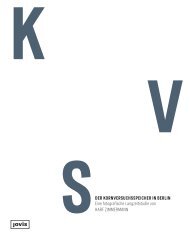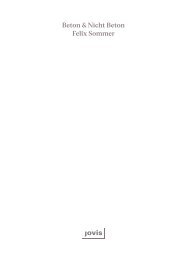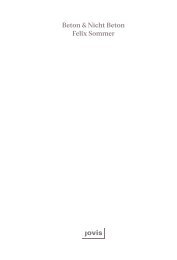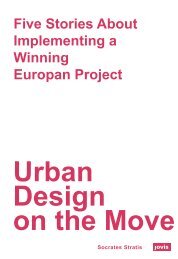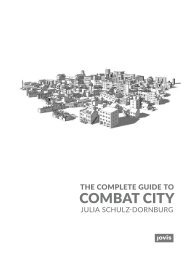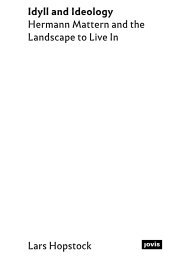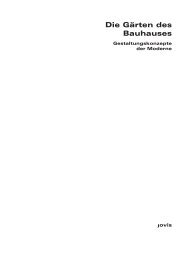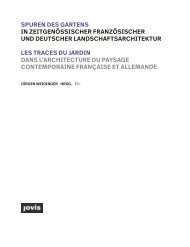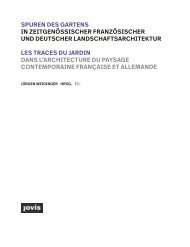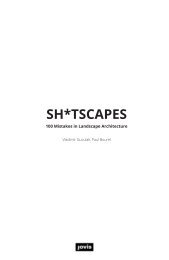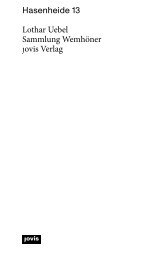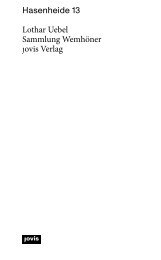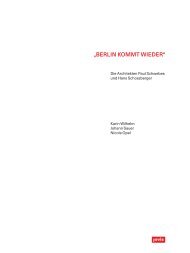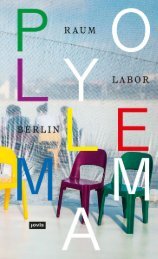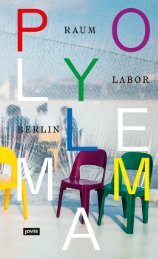(urban potentials)
ISBN 978-3-939633-81-5
ISBN 978-3-939633-81-5
- No tags were found...
Create successful ePaper yourself
Turn your PDF publications into a flip-book with our unique Google optimized e-Paper software.
Inhalt /Contents<br />
( 12 )<br />
VORWORT / PREFACE<br />
( 14 )<br />
Einleitung<br />
URBAN POTENTIALS –<br />
PERSPEKTIVEN EUROPÄISCHER<br />
STADTRÄUME IN<br />
GEGENWÄRTIGER KUNST<br />
Frank Eckhardt<br />
( 257 )<br />
Introduction<br />
URBAN POTENTIALS –<br />
EXAMINING THE POTENTIAL<br />
OF URBAN SPACES AND<br />
CONTEMPORARY ART IN EUROPE<br />
Frank Eckhardt<br />
( 321 )<br />
Biografien /Biographies
Über die Städte, die Künste und das Öffentliche<br />
About Cities, the Arts, and the Public Sphere<br />
( 21 )<br />
Rotterdam<br />
FORMEN, PERSPEKTIVEN<br />
UND REZEPTIONEN<br />
ZEITGENÖSSISCHER<br />
KUNST ALS BEITRAG ZUR BILDUNG<br />
URBANER IDENTITÄTEN<br />
( 259 )<br />
DESIGNS, PERSPECTIVES<br />
AND PERCEPTIONS OF THE<br />
CONTEMPORARY VISUAL ARTS<br />
WITH REGARD TO THE<br />
FORMATION OF THE URBAN<br />
COMMUNITY.<br />
Thomas Meijer zu Schlochtern<br />
( 27 )<br />
Salzburg<br />
«… EIN AUF DER OBERFLÄCHE<br />
SCHÖNER, ABER UNTER DIESER<br />
OBERFLÄCHE TATSÄCHLICH<br />
FÜRCHTERLICHER FRIEDHOF DER<br />
PHANTASIEN UND WÜNSCHE … »<br />
(THOMAS BERNHARD)<br />
( 261 )<br />
«… A BURIAL GROUND OF FANTASIES<br />
AND DESIRES, PRETTY ON THE SURFACE,<br />
BUT FRIGHTFUL UNDERNEATH …»<br />
(THOMAS BERNHARD)<br />
Hildegard Fraueneder<br />
( 43 )<br />
Budapest<br />
ICH SEHE WAS, WAS DU<br />
NICHT SIEHST …<br />
( 269 )<br />
I SPY WITH<br />
MY LITTLE EYE …<br />
Rita Kálmán<br />
( 49 )<br />
Dresden<br />
MEHR WUNDER<br />
AUS DRESDEN<br />
( 272 )<br />
MORE MIRACLES<br />
FROM DRESDEN<br />
Christiane Mennicke<br />
( 35 )<br />
Wrocław<br />
LEBENDIGKEIT<br />
DER KULTUR<br />
( 265 )<br />
LIVELY CULTURE<br />
Jolanta Bielańska
Über Bilder – Imageproduktion und Selbstbetrachtung<br />
About Images—Corporate Identities and Self-reflection<br />
( 58 )<br />
TOURIST BUBBLE EVERYWHERE.<br />
Tourismus, Differenz und die<br />
Touristifizierung des Alltags<br />
( 275 )<br />
TOURIST BUBBLE EVERYWHERE.<br />
Tourism, Difference, and the<br />
Touristification of the Everyday<br />
Michael Zinganel<br />
( 68 )<br />
The Randomroutines<br />
BUDAPEST<br />
Kahle Wände: Die Große Samenrettung /<br />
Blank Walls: The Great Seed Rescue<br />
( 72 )<br />
STÄDTISCHE EIGENLOGIK.<br />
RAUMSOZIOLOGISCHE PERSPEKTIVEN<br />
AUF STÄDTE<br />
( 280 )<br />
A CITY’S OWN LOGIC.<br />
THE PERSPECTIVE OF SPATIAL<br />
SOCIOLOGY ON URBAN THEORY<br />
Martina Löw<br />
( 82 )<br />
Hildegard Fraueneder / Erik Hable<br />
SALZBURG<br />
Zeitung<br />
Newspaper<br />
( 86 )<br />
Sándor Bodó Nagy<br />
BUDAPEST/DRESDEN<br />
Wellenzählmaschine<br />
Wavecounter<br />
( 90 )<br />
Didi Neidhart<br />
SALZBURG<br />
Sommer in der Stadt<br />
Summer in the city<br />
<strong>urban</strong> sounds<br />
( 92 )<br />
Fritz Rücker<br />
SALZBURG<br />
Movie BBQ –<br />
Die Stadt im Film<br />
Movie BBQ—Cities in film
Über Hoheiten – Kommunales Vermögen vs. privatwirtschaftlicher Zugriff<br />
About Sovereignty—Municipal Property vs. Private Sector Access<br />
( 96 )<br />
DELTAVILLES<br />
Europäische Stadtentwicklung im Zeichen<br />
von Ökonomisierung, Entdemokratisierung<br />
und Inszenierung.<br />
( 286 )<br />
DELTAVILLES.<br />
European Urban Development<br />
Under Economization, De-Democratization,<br />
and Self-Staging<br />
Yvonne P. Doderer<br />
( 106 )<br />
DIE RÜCKKEHR DER STÄDTE?<br />
Urbane Turbulenzen im östlichen Europa<br />
( 292 )<br />
RETURN OF THE CITY?<br />
Urban Upheaval in Eastern Europe<br />
Regina Bittner<br />
( 118 )<br />
Dré Wapenaar<br />
DRESDEN /ROTTERDAM<br />
Ein Souk für Dresden<br />
A souk for Dresden<br />
( 122 )<br />
Miklós Mécs<br />
BUDAPEST<br />
Stethoskop – Schaufenster<br />
Stethoscope—shop window<br />
( 126 )<br />
Jerzy Kosałka<br />
WROCŁAW<br />
CosalCa<br />
CosalCa<br />
( 130 )<br />
Dorit Ehlers,<br />
Erik Hable, Roland Kretzl,<br />
Gisela Ruby & Fritz Rücker<br />
SALZBURG<br />
Urban professional services<br />
Urban professional services<br />
( 134 )<br />
Eva Heitzinger / Marianne Lang<br />
SALZBURG<br />
Parklücke<br />
Parking space<br />
( 138 )<br />
Hildegard Fraueneder / Erik Hable<br />
SALZBURG<br />
Magazin<br />
Magazine<br />
( 142 )<br />
Dorit Ehlers, Erik Hable,<br />
Andreas Greiml & Birgit Sattlecker<br />
SALZBURG<br />
Testbibliothek<br />
Test Library
Über Bilder – Imageproduktion und Selbstbetrachtung<br />
About Images—Corporate Identities and Self-reflection<br />
( 58 )<br />
TOURIST BUBBLE EVERYWHERE.<br />
Tourismus, Differenz und die<br />
Touristifizierung des Alltags<br />
( 275 )<br />
TOURIST BUBBLE EVERYWHERE.<br />
Tourism, Difference, and the<br />
Touristification of the Everyday<br />
Michael Zinganel<br />
( 68 )<br />
The Randomroutines<br />
BUDAPEST<br />
Kahle Wände: Die Große Samenrettung /<br />
Blank Walls: The Great Seed Rescue<br />
( 72 )<br />
STÄDTISCHE EIGENLOGIK.<br />
RAUMSOZIOLOGISCHE PERSPEKTIVEN<br />
AUF STÄDTE<br />
( 280 )<br />
A CITY’S OWN LOGIC.<br />
THE PERSPECTIVE OF SPATIAL<br />
SOCIOLOGY ON URBAN THEORY<br />
Martina Löw<br />
( 82 )<br />
Hildegard Fraueneder / Erik Hable<br />
SALZBURG<br />
Zeitung<br />
Newspaper<br />
( 86 )<br />
Sándor Bodó Nagy<br />
BUDAPEST/DRESDEN<br />
Wellenzählmaschine<br />
Wavecounter<br />
( 90 )<br />
Didi Neidhart<br />
SALZBURG<br />
Sommer in der Stadt<br />
Summer in the city<br />
<strong>urban</strong> sounds<br />
( 92 )<br />
Fritz Rücker<br />
SALZBURG<br />
Movie BBQ –<br />
Die Stadt im Film<br />
Movie BBQ—Cities in film
Über Hoheiten – Kommunales Vermögen vs. privatwirtschaftlicher Zugriff<br />
About Sovereignty—Municipal Property vs. Private Sector Access<br />
( 96 )<br />
DELTAVILLES<br />
Europäische Stadtentwicklung im Zeichen<br />
von Ökonomisierung, Entdemokratisierung<br />
und Inszenierung.<br />
( 286 )<br />
DELTAVILLES.<br />
European Urban Development<br />
Under Economization, De-Democratization,<br />
and Self-Staging<br />
Yvonne P. Doderer<br />
( 106 )<br />
DIE RÜCKKEHR DER STÄDTE?<br />
Urbane Turbulenzen im östlichen Europa<br />
( 292 )<br />
RETURN OF THE CITY?<br />
Urban Upheaval in Eastern Europe<br />
Regina Bittner<br />
( 118 )<br />
Dré Wapenaar<br />
DRESDEN /ROTTERDAM<br />
Ein Souk für Dresden<br />
A souk for Dresden<br />
( 122 )<br />
Miklós Mécs<br />
BUDAPEST<br />
Stethoskop – Schaufenster<br />
Stethoscope—shop window<br />
( 126 )<br />
Jerzy Kosałka<br />
WROCŁAW<br />
CosalCa<br />
CosalCa<br />
( 130 )<br />
Dorit Ehlers,<br />
Erik Hable, Roland Kretzl,<br />
Gisela Ruby & Fritz Rücker<br />
SALZBURG<br />
Urban professional services<br />
Urban professional services<br />
( 134 )<br />
Eva Heitzinger / Marianne Lang<br />
SALZBURG<br />
Parklücke<br />
Parking space<br />
( 138 )<br />
Hildegard Fraueneder / Erik Hable<br />
SALZBURG<br />
Magazin<br />
Magazine<br />
( 142 )<br />
Dorit Ehlers, Erik Hable,<br />
Andreas Greiml & Birgit Sattlecker<br />
SALZBURG<br />
Testbibliothek<br />
Test Library
Über Auftritte – Theatrale Erprobungen von Stadträumen<br />
About Performances—Theatrical Investigations of Urban Spaces<br />
( 148 )<br />
WIDERLAGER ODER SOZIALER KITT?<br />
Wie gestaltet, wie agiert Kunst in globalen<br />
Interaktionsräumen? Von Ökonomisierung,<br />
Entdemokratisierung und Inszenierung –<br />
Abschlusspanel der Konferenz Urban Potentials<br />
( 299 )<br />
COUNTER-SITES OR SOCIAL GLUE?<br />
What is the influence of art and how does it operate<br />
within global interaction spaces?<br />
Closing panel of the Urban Potentials conference<br />
Teilnehmer/-innen /Participants:<br />
Moira Zoitl, Künstlerin /artist, Salzburg<br />
Marcin Szczelina, Kurator /curator, Wrocław<br />
Stefan Bendiks, Architekt /architect, Rotterdam<br />
Moderation/presentation: Christiane Mennicke,<br />
Direktorin des /director of Kunsthaus Dresden<br />
( 160 )<br />
Gábor Kerekes<br />
BUDAPEST<br />
Plattform: mobile Straßenbühne<br />
Platform: Mobile Street Stage<br />
( 164 )<br />
AMBIVALENZEN UND WIDERSPRÜCHE<br />
TEMPORÄRER RAUMNUTZUNGEN<br />
( 306 )<br />
AMBIVALENCE AND CONTRADICTION IN<br />
THE TEMPORARY USE OF SPACE<br />
Florian Haydn<br />
( 170 )<br />
V 3 – Andrzej Dudek-Dürer,<br />
Jerzy Kosałka & Tomasz Bajer<br />
WROCŁAW / DRESDEN<br />
YAPPER<br />
( 174 )<br />
Marc Floßmann<br />
DRESDEN<br />
MEDIALE FÜRSORGE<br />
Media care<br />
( 178 )<br />
Thomas Beck, Dorit Ehlers, Erik Hable,<br />
Sabine Jenichl, Gisela Ruby & Arthur Zgubic<br />
SALZBURG<br />
Wohnproben #1<br />
Living rehearsal #1<br />
( 182 )<br />
Ulrike Gollesch, Petra Polli,<br />
Melanie Schiefer & Severin Weiser<br />
SALZBURG<br />
Transformer<br />
Transformer<br />
( 186 )<br />
Tomasz Bajer<br />
WROCŁAW / DRESDEN<br />
Kunstkapsel<br />
Art Capsule<br />
( 190 )<br />
Andrzej Dudek-Dürer<br />
WROCŁAW / DRESDEN<br />
Living sculpture<br />
Living sculpture<br />
( 194 )<br />
Miklós Mécs<br />
DRESDEN<br />
Denkmal des kleinen Mannes<br />
Monument of the everyday man<br />
( 198 )<br />
David Moises<br />
SALZBURG<br />
Steckenpferd<br />
Hobbyhorse<br />
( 202 )<br />
DIE STADT IST KEINE BÜHNE<br />
( 310 )<br />
THE CITY IS NOT A STAGE<br />
Gregor Langenbrinck
Über Pläne – Vom Nutzen des Gemeinsinns<br />
About Plans—The Benefit of Public Spirit<br />
( 208 )<br />
FLUCHTEN AUS DER<br />
„ARBEIT AN DER GEMEINSCHAFT“<br />
( 312 )<br />
ESCAPING FROM<br />
“ WORK ON THE COMMUNITY”<br />
Gerald Raunig<br />
( 214 )<br />
anschlaege.de<br />
DRESDEN<br />
7. Stock<br />
7th floor<br />
( 218 )<br />
Erik Hable, Ralf Hoedt,<br />
Fritz Rücker & Moira Zoitl<br />
SALZBURG<br />
Dresden, 328.3 km²<br />
Salzburg, 65.7 km²<br />
( 222 )<br />
‚NEGATIVE’ RÄUME<br />
POSITIV GESEHEN<br />
( 315 )<br />
‘NEGATIVE’ SPACES<br />
IN A POSITIVE LIGHT<br />
Péter Gauder<br />
( 226 )<br />
INTERNATIONAL INFORMAL STYLE?<br />
Nach einem Vortrag in der<br />
Motorenhalle Dresden<br />
( 317 )<br />
INTERNATIONAL INFORMAL STYLE?<br />
Based on a talk given in<br />
the Motorenhalle, Dresden<br />
Jochen Becker / metroZones<br />
( 232 )<br />
Workshop<br />
DRESDEN<br />
Ein Haus der Arbeit in Zukunft.<br />
Idee für die Nutzung eines<br />
Druckereigebäudes in Dresden<br />
A Future Place of Work.<br />
Proposal for using a Printing<br />
Works Building in Dresden<br />
( 236 )<br />
Erik Hable & periscope<br />
SALZBURG<br />
Geschmacksverstärker.<br />
sunday soup & talk<br />
Geschmacksverstärker.<br />
sunday soup & talk<br />
( 240 )<br />
white club<br />
SALZBURG<br />
Wir gehen auf Reisen!<br />
We hit the road!<br />
( 244 )<br />
Andrea Knobloch & Silke Riechert<br />
DRESDEN<br />
rundkino_modell: station<br />
rundkino_modell: station<br />
( 250 )<br />
Moira Zoitl / Ralf Hoedt<br />
SALZBURG<br />
Salzburg – Stadtplan & Booklet<br />
Salzburg—city map & booklet<br />
( 254 )<br />
Mónika Bálint, Balázs Horváth,<br />
Rebeka Pál & Kata Soós<br />
BUDAPEST<br />
Film-picnic<br />
Film picnic
( 12 )<br />
Urban Potentials<br />
VORWORT / PREFACE<br />
Dieses Buch bildet einen zweijährigen Arbeitsprozess ab: zwei Jahre mit Ausstellungen, Interventionen,<br />
Diskussionen, Vorträgen und Workshops in Städten in Europa, mit Künstlern/-innen, Architekten/-innen,<br />
Soziologen/-innen, Kulturwissenschaftlern/-innen. Sie verband ein ebenso emphatisches<br />
wie kritisches Verhältnis zu ‚der Stadt‘ und zu den Städten, in denen sie leben, die Reflexion<br />
über Optionen künstlerischen und politischen Handelns und die attraktive Gelegenheit,<br />
eigene Erfahrungen und Konzepte mit denen anderer in Beziehung zu setzen. Die Aktivitäten<br />
pendelten fortwährend zwischen Orten und Diskursen der eigenen Stadt und dem Hinaustreten<br />
in einen europäischen Städteverbund, dessen Verfassung sich als widersprüchlich erwies. Entgegen<br />
jeder harmonisierenden Rhetorik des wieder vereinigten ‚Europa‘ ist jede Stadt ihren eigenen<br />
lokalen Traditionen und Repräsentationsmodellen gefolgt und hat ihre eigenen Charaktere widerstandsfähiger<br />
Praktiken entwickelt.<br />
Gruppenbasierte Aktivitäten wurden erprobt und realisiert als mögliche Entgegnung auf eine<br />
ökonomisch dominierte Stadtentwicklung, Pluralität missachtende Außendarstellungen und<br />
‚Raum‘ verschließende Anmaßungen von Planung und Codierung. Die Rolle der Künstlerinnen<br />
und Künstler fächerte sich auf zwischen dem Beharren auf einer eigenständigen Methodik und<br />
der Bereitschaft zu Disziplinen überschreitendem Handeln. Stadtpläne wurden umgeschrieben,<br />
buchstäblich und symbolisch, neue Akteure in die Stadtpolitik eingeschleust und freie Flächen<br />
dem Nutzungsterror abgewonnen.<br />
Dies alles vor dem Hintergrund gänzlich unterschiedlicher Stadtgeschichten und schwer fassbarer<br />
‚Lebensgefühle‘: das Abtragen des Gerölls mythisierter Schlüsselreize in Salzburg und Dresden<br />
stand neben schon gebrochenen Aufbruchstimmungen in Wrocław und Budapest und dem<br />
vermeintlich ewig fortschrittlichen Rotterdam. ‚Kultur‘ schließlich wird allerorten großgeschrieben,<br />
doch auch dieser Überschrift folgen unterschiedliche Erzählungen.<br />
Unser Dank gilt allen Teilnehmern/-innen, aus deren Beiträgen das Projekt überhaupt erst<br />
entstehen konnte. Wir danken der Europäischen Union mit ihrem Programm ‚Kultur 2000‘ und<br />
allen anderen Förderern und Sponsoren für ihre großzügige Unterstützung.
This publication maps a two-year working process: two years of exhibitions, interventions, discussions,<br />
lectures, and workshops in European cities, with artists, architects, sociologists, and cultural<br />
workers. All of the participants shared both an emphatic and critical relationship to ‘the city’ and the<br />
cities in which they live, reflecting on the options of artistic and political activities and the attractive<br />
opportunity to share one’s own experiences and concepts with those of others. The activities oscillated<br />
between the sites and discourses of the participants’ own cities and a network of European cities, in<br />
which a variety of conflicting conditions can be observed. Despite the rhetoric of harmonization<br />
within a re-united ‘Europe’, every city followed its own local traditions and models of representation,<br />
leading to unique practices of resistance.<br />
Group-based activities were tested and realized as a feasible reply to a form of <strong>urban</strong> development<br />
dominated by economics; to corporate identities that disregard diversity; and to the hubris of<br />
planning and the codification of space. The roles of the artists ranged from an insistence on their own<br />
specific methods and the disposition to engage in cross-border actions. City maps were rewritten, literally<br />
and symbolically; new players infiltrated city politics; and open spaces were reclaimed from the<br />
terror of utilization.<br />
The backdrop to all of this was formed by very different city histories, by feelings and views on<br />
life that are difficult to capture in words. Debunking myths and worn-out ideals in Salzburg and<br />
Dresden took place alongside analyzes of the ebbing euphoria in Wrocław and Budapest and a<br />
clearer look at the ostensibly always forward-looking city of Rotterdam. Everywhere, high value is<br />
placed on Culture with a capital C, but below this standardized headline different narratives begin<br />
to appear.<br />
We would like to thank all of the participants. This project would not have been possible without<br />
their ideas and contributions. We are also grateful to the European Union and its ‘Kultur 2000’<br />
program, as well as to all other sponsors and contributors, for their generous support.
( 68 )<br />
The Randomroutines<br />
BUDAPEST
Kahle Wände:<br />
Die Große Samenrettung<br />
( Blank Walls: The Great Seed Rescue )<br />
Budapest ist voll von kahlen Wänden. Während es in anderen europäischen Städten, wie etwa Berlin,<br />
zahlreiche schöne Beispiele einer künstlerischen, nicht-kommerziellen Aneignung und Gestaltung gibt,<br />
hat sich diese einfache, gleichwohl eindrucksvolle Strategie, den öffentlichen Raum zu gestalten, in Budapest<br />
noch nicht durchgesetzt. Die ‚Optik‘ der Stadt wird dominiert von selbstsüchtigen und auffordernden<br />
Botschaften der Werbung und unterschiedlichen ‚Informations-Oberflächen‘. Die Randomroutines<br />
wollten mit ihrem Projekt einen Anstoß geben, um ähnliche Projekte in der Stadt anzuregen. Unsere<br />
Gestaltung der Wandfläche sollte also nicht eine eindimensionale Botschaft transportieren, die den<br />
Betrachtern nichts anderes übrig lässt, als sie wahrzunehmen, zuzustimmen oder sie abzulehnen. Wichtig<br />
war, dass die Gestaltung Erwachsene und Kinder gleichermaßen ansprechen sollte. Entsprechend dem<br />
Standort der Fläche sollte das Bild sowohl in den Hof des Kindergartens hinein als auch auf die Straße<br />
hinaus wirken.<br />
Deshalb wurden fantastische, märchenhafte Szenen mit solchen aus wissenschaftlichen Publikationen<br />
kombiniert. Uns interessierte das komplexe Verhältnis der Errungenschaften der Zivilisation und<br />
der sich organisch entwickelnden Natur. Statt einer klaren Aussage über dieses Verhältnis, zu dem die<br />
Betrachter sich verhalten müssten, wollten wir sie zu einer eigenen Reflexion anregen. Auch unsere Entscheidung,<br />
das Wandbild von Rankpflanzen nach und nach überwuchern zu lassen, hat mit diesem Verhältnis<br />
von Kultur und Natur zu tun. Diese Geste richtet sich gegen den Ewigkeitsanspruch von Denkmälern.<br />
Die Welt ist in einem kontinuierlichen Fluss von Bewegung und Veränderung. Die Entscheidung<br />
für die Rankpflanzen hing aber auch mit unserem Wunsch nach mehr Grün in einer Stadt zusammen,<br />
wo derzeit zahlreiche Grünanlagen überbaut und Parks in Parkplätze verwandelt werden.<br />
Budapest is full of blank walls. Whereas in other European cities, especially in Berlin, there are many beautiful<br />
examples of the artistic, non-commercial use of such spaces, in Budapest this relatively economical, simple,<br />
yet spectacular method of shaping public places has hardly been exploited. The visual appearance of our city<br />
is dominated primarily by the self-evident and didactic messages of advertisements and various information<br />
surfaces. The Randomroutines intend to set a stimulating example with this work, promoting similar projects<br />
throughout the city and even making this kind of public art a special feature of Budapest. We intend to use<br />
wall painting in such a way that it will not simply depict a concrete, self-evident meaning. Instead, the aim of<br />
the fresco will be to stimulate the viewer’s imagination and generate individual readings. It was important for<br />
us that it be exciting both for children and adults. In line with its location, the wall painting should have an<br />
inward effect, extending into the courtyard of the day-care center, and an outward effect, towards the street.<br />
This is why fantastic, fairytale-like scenes are mingled with images from scientific publications. In terms<br />
of content, we were interested in the problematic tension, the delicate balance, between the deliberate formative<br />
endeavors of human culture and organically growing and developing aspects of nature. However, rather<br />
than providing a concrete answer or a statement, we invite everyone to think about these issues themselves.<br />
Our intention to allow creepers to grow from the bottom of the wall so that they slowly cover the entire<br />
picture is also related to the duality of culture and nature. This gesture reflects the fact that we do not believe in<br />
bronze statues that are erected for eternity, only to be knocked over. The world is in a state of continuous movement<br />
and change. Moreover, the creepers climbing the wall are a sign of our desire to see more green areas in<br />
Budapest, where today the general tendency is to build up green areas and convert parks into parking garages.
( 134 )<br />
Eva Heitzinger / Marianne Lang<br />
SALZBURG
Parklücke<br />
( Parking Space )<br />
Straßen werden heute vorrangig autogerecht geplant und ausgestattet, ihre Bedeutung als kommunikative<br />
Schnittstelle für Menschen geht sukzessive verloren. Effizienz und Sicherheit verdrängen zunehmend ihre<br />
Multifunktionalität in Bezug auf eine durchmischte kollektive Nutzung; das gilt für auf Konsum getrimmte<br />
Fußgängerzonen ebenso wie hinsichtlich der ökonomischen Ausgestaltungen städtischer Flächen für den<br />
fließenden und den ruhenden Verkehr. Die Straße ist aber immer auch der Ort politischer und kultureller<br />
Demonstrationen gewesen – in ihrer Nutzung sind immer auch Machtkonflikte verhandelt und Machtverhältnisse<br />
zum Ausdruck gebracht worden.<br />
Wir behaupten: Straßen sind öffentliche Räume. Kollektiv nutzbar und temporär in Besitz zu nehmen.<br />
Parkplätze sind im Vergleich zu allen anderen öffentlichen Räumen käuflich: Eine Münze in den Automaten<br />
und der Platz ist für eine bestimmte Zeit angemietet.<br />
In vier situativen Nutzungen wurde der Pragmatismus einer verkehrstechnisch optimierten Verwendung<br />
auf seine sozialen und kollektiven Verträglichkeiten getestet. Aus einer durchschnittlichen Fläche von<br />
jeweils 380 x 190 cm zwischen Gehsteigkante und Verkehrsfläche wurden private Orte zur Selbstverwirklichung<br />
und Orte einer parasitären gewerblichen Nutzung.<br />
Today’s streets are planned and furnished primarily with cars in mind; their significance as a communicative<br />
interface for people is successively diminishing. Efficiency and security are increasingly supplanting the<br />
multifunctionality of streets in terms of their mixed, collective use. This applies just as much to pedestrian<br />
zones tailored to consumerism as it does to the economically oriented transformation of <strong>urban</strong> spaces to accommodate<br />
moving and stationary traffic.<br />
The street, however, is always also a place for political and cultural demonstrations—a place where<br />
power conflicts are negotiated and power structures are put in the spotlight.<br />
We assert that streets are public spaces, to be used collectively and appropriated temporarily. In contrast<br />
to all other public places, parking spaces can be purchased: put a coin into the parking meter and you’ve<br />
rented the space for a certain time.<br />
In four different contexts of use, the pragmatism of optimizing spaces for traffic is called into question<br />
by testing the capacity of this approach to fulfill social and collective needs.<br />
Spaces averaging 380 x 190 cm in size and located between the edge of the pavement and the street<br />
were transformed into places for self-development and parasitic commercial use.
( 144 )<br />
Dorit Ehlers, Erik Hable,<br />
Andreas Greiml & Birgit Sattlecker<br />
SALZBURG
( 178 )<br />
Thomas Beck, Dorit Ehlers,<br />
Erik Hable, Sabine Jenichl,<br />
Gisela Ruby & Arthur Zgubic<br />
SALZBURG<br />
„Wir sitzen alle im selben Boot Bett“ / “We’re all in the same boat”<br />
„alles kommt raus“ / “Everything must go”
Wohnproben #1<br />
( Living rehearsal #1 )<br />
------------------------------------------------------------<br />
RÄUME MIT AUSSICHTEN<br />
MIETFREI, MÖBLIERT, MIT<br />
MÖGLICHKEITEN<br />
------------------------------------------------------------<br />
wo gibt es in salzburg das ‚beste‘ setting?<br />
in den kulissen und studios von ikea.<br />
------------------------------------------------------------<br />
während der normalen geschäftszeiten nutzte eine<br />
gruppe von akteuren/-innen diese räumlichkeiten<br />
für szenische miniaturen.<br />
------------------------------------------------------------<br />
wir erstellten ein fotoalbum/bilderbuch.<br />
hier zu sehen – erste fotos fürs fotoalbum vom<br />
shooting in den größten und günstigsten ‚filmstudios<br />
salzburgs‘. aus den schauräumen und<br />
verkaufskojen des schwedischen möbelhauses.<br />
jeder beitrag war willkommen, jeder schnappschuss<br />
ein treffer.<br />
------------------------------------------------------------<br />
filmst du noch oder spielst du schon?<br />
------------------------------------------------------------<br />
fortsetzung folgt.<br />
------------------------------------------------------------<br />
------------------------------------------------------------<br />
ROOMS WITH A VIEW<br />
NO RENT, FURNISHED,<br />
WITH POSSIBILITIES<br />
------------------------------------------------------------<br />
Where is the ‘best’ setting in Salzburg?<br />
In Ikea‘s studios and showrooms.<br />
------------------------------------------------------------<br />
During normal opening hours,<br />
a group of actors used these spaces to<br />
create scenic miniatures.<br />
------------------------------------------------------------<br />
We created a photo album/picture book.<br />
Here you can see the first pictures for the<br />
album from the photo shooting in the biggest<br />
and cheapest film studios in Salzburg.<br />
From the showrooms and display racks<br />
of the Swedish furniture store. Every contribution<br />
was welcome, every snapshot a success!<br />
------------------------------------------------------------<br />
filmst du noch oder spielst du schon?*<br />
------------------------------------------------------------<br />
to be continued…<br />
------------------------------------------------------------<br />
* pun on an IKEA advertising slogan in Germany
( 194 )<br />
Miklós Mécs<br />
DRESDEN
Denkmal des kleinen Mannes<br />
( Monument to the everyday man )<br />
Dresden ist 800 Jahre alt.<br />
Ich stand der Hetzerei, die Geburtstagspartys umgibt, schon immer verständnislos gegenüber. Zunächst<br />
stellt sich die Frage, wieso eigentlich das Geburtstagskind bei diesem Ereignis im Mittelpunkt steht. Auch<br />
die umgekehrte Situation wäre logisch, wenn aus Anlass dieses besonderen Tages das Geburtstagskind jene<br />
feiert, denen es das Leben und Dasein am meisten verdankt. Auf dieser einfachen Idee basiert das Denkmal<br />
des kleinen Mannes. Es lenkt den Blick auf die Dresdner Durchschnittsbürger/-innen, jene Zielgruppe, die<br />
ich als eine der größten Ressourcen der Stadt verstehe.<br />
Wegen der riesigen Ausmaße des Sockels können wir die klein geratene Skulptur nicht richtig bewundern,<br />
nicht sehen, dass das äußere Erscheinungsbild mit Anzug einen weiblichen Körper verdeckt. Die<br />
Skulptur besteht aus einem folienartigen Material, mit dem Denkmäler im öffentlichen Raum zum Schutz<br />
vor verschiedenen Umwelteinflüssen abgedeckt werden. Sie wurde am Platz vor dem Rathaus aufgestellt.<br />
Der Sockel ist eine maßstabsgerechte, aber auf den Kopf gestellte Kopie der Sockel der vorhandenen Fahnenmasten.<br />
Dresden is 800 years old.<br />
I’ve never understood the hubbub surrounding birthday parties. One of the first things I ask myself is why<br />
the birthday boy or girl is always at the center of attention. After all, it would also make sense to do things<br />
the other way around, celebrating on our birthdays the people to whom we owe our lives and existence the<br />
most. The Monument to the Everyday Man is based on this simple idea and focuses on the average resident<br />
of Dresden—the target group I identified as one of the city’s greatest resources.<br />
Because of the enormous size of the pedestal we cannot really admire the small-scale statue, we cannot<br />
see the male-like suit covering a female body. The sculpture consists of a foil-like material used to cover statues<br />
in <strong>urban</strong> space to protect them against environmental conditions. The monument was positioned in front of<br />
City Hall. The pedestal was scaled to the existing pedestals of the flagstaffs, but turned upside down.
( 218 )<br />
Erik Hable, Ralf Hoedt,<br />
Fritz Rücker, Moira Zoitl<br />
SALZBURG
Dresden, 328.3 km²<br />
Salzburg, 65.7 km²
( 236 )<br />
Erik Hable & periscope<br />
SALZBURG<br />
jetzt neu
Geschmacksverstärker.<br />
sunday soup & talk<br />
GESPRÄCHE ZU THEMEN DER BILDENDEN KUNST<br />
TALKS ABOUT THEMES IN VISUAL ART<br />
Eine Kooperation mit /In cooperation with „periscope für Kunst und Zeitgenossen“<br />
Projektidee & Durchführung /Project design and implementation: Erik Hable<br />
------------------------------------------------------------------------------------------------------------------------------<br />
5. November 2006 /5 Nov 2006<br />
Bedingungen zeitgenössischer Kunstproduktion in Salzburg<br />
Conditions of Contemporary Art Production in Salzburg<br />
mit/with: Eva Heitzinger (Künstlerin/artist), Wolfgang Schäffer (Künstler/artist)<br />
------------------------------------------------------------------------------------------------------------------------------<br />
12. November 2006/12 Nov 2006<br />
Gewalt und Sexualität als Themenverflechtung in der Malerei<br />
Violence and Sexuality as Intertwined Themes in Painting<br />
mit/with: Stefan Heizinger (Künstler/artist), Peter Keller (Kunsthistoriker, Leiter des Dommuseums/art<br />
historian, director of the Dom Museum) und Hildegard Fraueneder (Kunsthistorikerin,<br />
Leiterin galerie5020/art scholar, director of galerie5020)<br />
------------------------------------------------------------------------------------------------------------------------------<br />
26. November 2006/26 Nov 2006<br />
„Was machst du als nächstes?“ Präsentations- und Produktionszusammenhänge in der zeitgenössischen Kunst.<br />
“What are you doing next?” Contexts of Presentation and Production in Contemporary Art<br />
mit/with: Bernhard Gwiggner (Künstler/artist), Clemens Kogler (Künstler/artist) und<br />
Moira Zoitl (Künstlerin/artist)<br />
------------------------------------------------------------------------------------------------------------------------------<br />
3. Dezember 2006/3 Dec 2006<br />
Gschichtldrucker. Über narrative Strukturen.<br />
‘Gschichtldrucker’ – About narrative structures<br />
mit/with: Ines Häufler (Lektorin, Script Consultant/editor, script consultant),<br />
Bernd Rohrauer (Künstler/artist) und Elisabeth Schmirl (Künstlerin/artist)<br />
------------------------------------------------------------------------------------------------------------------------------<br />
17. Dezember 2006/17 Dec 2006<br />
Zeichnung. Ohne weiteren erklärenden Untertitel.<br />
Drawing. Without explanatory subtitle.<br />
mit/with: Tania Hölzl (Kunsthistorikerin/art scholar), Marianne Lang (Künstlerin/artist),<br />
Bernhard Lochmann (Künstler/artist), Robert Neuhauser (Künstler/artist)<br />
------------------------------------------------------------------------------------------------------------------------------<br />
14. Januar 2007/14 Jan 2007<br />
Hoit‘s zsamm – Sammeln & Archivieren<br />
Hoit‘s zsamm – Collecting & Archiving<br />
mit/with: Elke Zobl (Kulturwissenschaftlerin/art scholar), Haydeé Jiménez (Kulturarbeiterin/cultural<br />
worker) und Alexandra Schüssler (Kulturanthropologin/cultural anthropologist)<br />
------------------------------------------------------------------------------------------------------------------------------
( 248 )<br />
Silke Riechert & Andrea Knobloch<br />
DRESDEN<br />
––Veranstaltungen<br />
Workshop, rundkino und TU Dresden<br />
05.05. - 07.05.2006<br />
Interdisziplinärer Workshop zur Erarbeitung eines kulturellen Neunutzungskonzepts<br />
für das Rundkino in Zusammenarbeit mit der Zeppelin University Friedrichshafen, der TU Dresden<br />
und Andreas Waschk Consulting, Köln<br />
Rundkino<br />
15.09.2006, ab 12 Uhr<br />
Putzaktion am Rundkino von und mit Studierenden des Masterstudiengangs<br />
Denkmalpflege & Stadtentwicklung, TU Dresden<br />
rundkino_modell: station<br />
15.09.2006, 17 Uhr<br />
Eröffnung der rundkino_modell: station<br />
auf der Prager Straße vor dem Rundkino<br />
rundkino_modell: station<br />
16.09.2006, 15 Uhr<br />
rundkino dresden e.V. lädt ein zum Kaffetrinken mit Rundkinotorten. Studierende des Masterstudiengangs<br />
Denkmalpflege & Stadtentwicklung stellen ihre Untersuchungsergebnisse zum Rundkino vor<br />
rundkino_modell: station<br />
22.09.2006, 19 Uhr Musikstation<br />
Musik und visionäre Lieblingsfilme der 60er / 70er
undkino_modell: station<br />
29.09.2006, 19 Uhr<br />
Zukunft der Innenstadt: Kommerzialisierung und<br />
Musealisierung oder Bürgerstadtraum?<br />
Eine Gesprächsrunde in Zusammenarbeit mit<br />
der Ausstellung Urban Potentials<br />
Eine Gesprächsrunde in Zusammenarbeit<br />
mit der Ausstellung Urban Potentials<br />
Gäste:<br />
Torsten Birne, Architekturkritiker und<br />
Kunsthistoriker, Dresden<br />
Gregor Langenbrinck, Kompetenzzentrum<br />
für revitalisierenden Städtebau, Görlitz (angefragt)<br />
Frank Eckhardt, ZukunftsWerk Stadt Dresden<br />
Christoph Heinemann, Ifau (Institut für angewandte<br />
Urbanistik, Berlin)<br />
Oliver Lücking, Jan Winkler, Kristina Hermann,<br />
Denise Ackermann, rundkino dresden e.V.<br />
rundkino<br />
07.10.2006<br />
Führung im Rundkino<br />
mit Studierenden der TU Dresden<br />
rundkino<br />
14.10.2006<br />
Vorstellung einer Machbarkeitsstudie zur<br />
zukünftigen Nutzung des Rundkinos<br />
von Studierenden der TU-Dresden und der<br />
Zeppelin-University Friedrichshafen<br />
Gäste:<br />
Oliver Lücking (rundkino dresden e.V.)<br />
Prof. Dr. Karen van den Berg<br />
(Zeppelin University Friedrichshafen)<br />
Manfred Wiemer (Kulturamt der<br />
Landeshauptstadt Dresden)<br />
Prof. Dr. Hans-Rudolf Meier (TU Dresden)




